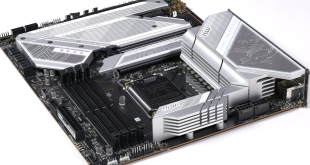Measuring in at around 12″ x 8.4″ ASRock's Z87 Killer uses the ‘narrow' ATX form factor. The motherboard still fits perfectly inside an ATX-capable chassis but the right-hand column of stand-offs are not required.
As with other motherboards in ASRock's Fatal1ty series, the Z87 Killer features a red and black colour scheme and specific branding relating to the champion gamer, Jonathan Wendel. The motherboard's brown PCB is ugly and does impact its overall attractiveness. We would have preferred a black PCB which wouldn't have added much to the manufacturing cost.
Up to 32GB of memory can be installed in the Z87 Killer's four DIMM slots. ASRock claims support for memory frequencies over 3GHz, but the maximum achievable speed will be heavily swayed by the CPU's IMC.
Cooled by a sturdy Fatal1ty-branded heatsink, eight power delivery phases feed an LGA 1150 CPU. ASRock positions the heatsink near the rear IO section which leaves plenty of room around the upper edge for oversized CPU coolers. On the flip side, this move forced some components (namely the MOSFETs) from the upper two phases to operate without direct cooling via a heatsink. Given the power-friendly nature of Haswell CPUs, this cooling restriction shouldn't cause long-term stability issues.
A digital controller provides operation for the CPU power delivery system.
A single Hi-Density 8-pin CPU power connector is located close to the VRM heatsink in an easy-to-access position. A pair of CPU fan headers is found above the DIMM banks, one of which 3-pin but is still controlled by the same PWM channel.
Six SATA 6Gb/s are located towards the middle of the board's right-edge with a 90 degree orientation. All six of the connections receive their bandwidth from the Z87 chipset.
An outwards-facing USB 3.0 header is placed in its typical location, adjacent to the 24-pin power connector. Its outwards-facing orientation will certainly increase the complexity of hiding the large front-panel cable. As was the case with the SATA connection, the USB 3.0 header is provided by the Z87 chipset.
Rapidly becoming commonplace on many of ASRock's Z87 motherboard, Purity Sound uses Realtek's ALC1150 audio codec to provide a 115 dB signal-to-noise-ratio. Other notable components which form the Purity Sound system include a pair Texas Instruments NE5532 operational amplifiers and isolated circuitry.
By providing its users with a high-quality onboard sound system, ASRock's Z87 Killer allows gamers to save the cash that a dedicated sound card would demand.
With such an emphasis on gaming performance, ASRock equips the Fatal1ty Z87 Killer with a Killer E2200 series NIC. ASRock suggests that the Killer E2200 series NIC can improve latency performance for network-heavy online games (such as LOL and DOTA 2) by a considerable margin. In reality, external factors such as a user's internet speed and the server's accessibility will have a huge impact on the performance improvements, if any.
Three full-length PCI-E slots and four x1 versions are used on the Fatal1ty Z87 Killer. The configuration should be acceptable for the majority of gamers, except those who are wanting to migrate an old PCI card. Slot spacing is also very good with two x1 and the bottom x16-length slots remaining accessible alongside a dual-VGA configuration.
An LGA 1150 processor's sixteen PCI-E 3.0 lanes are split as x16/x0/x0 for single-card usage or x8/x8/x0 for dual-card operations. Users wanting to use three high-bandwidth expansion cards will be forced to settle for x8/x4/x4 link speeds. These levels of throughput are still perfectly acceptable for CrossFire configurations, but not for the x8-demanding SLI alternative.
Multi-card configurations with 3-slot coolers are supported thanks to the previously mentioned effective slot layout on ASRock's behalf.
Headers are found in their typical locations along the motherboard's bottom-edge – audio to the left and front panel connections to the right. A downwards-facing molex connector provides power for multi-card configurations and, thanks to its orientation, is unlikely to negatively impact cable management efforts.
ASRock opts for a dual-BIOS implementation which provides redundancy against motherboard-bricking corruptions.
As well as the standard affair of rear panel connections, ASRock's Z87 Killer features support for HDMI pass-through. The feature allows an HDMI device (such as a games console) and a user's system to plug into the same monitor input. The Fatal1ty mouse port provides manipulation of the polling rate of a mouse via ASRock's F-Stream software.
Motherboard rear ports:
- 1 x PS/2 Mouse/Keyboard Port
- 1 x D-Sub Port
- 1 x DVI-D Port
- 1 x HDMI-Out Port
- 1 x HDMI-In Port
- 1 x Optical SPDIF Out Port
- 3 x USB 2.0 Ports
- 1 x Fatal1ty Mouse Port (USB 2.0)
- 4 x USB 3.0 Ports
- 1 x RJ-45 LAN Port with LED (ACT/LINK LED and SPEED LED)
- HD Audio Jacks: Rear Speaker / Central / Bass / Line in / Front Speaker / Microphone
Circled in the above image are the locations of the Z87 Killer's six fan headers. The two headers above the DIMM slots are controlled by the CPU's channel in the BIOS. Three of the remaining four headers feature speed control, while one operates as a powered 3-pin connection.
ASRock positions a 3-header cluster near the VRM heatsink which will make cable management tricky. Shifting two of those headers nearer the SATA ports would have been beneficial to cable management efforts. Users with side panel chassis fans can use the header along the Z87 Killer's bottom edge.
 KitGuru KitGuru.net – Tech News | Hardware News | Hardware Reviews | IOS | Mobile | Gaming | Graphics Cards
KitGuru KitGuru.net – Tech News | Hardware News | Hardware Reviews | IOS | Mobile | Gaming | Graphics Cards














